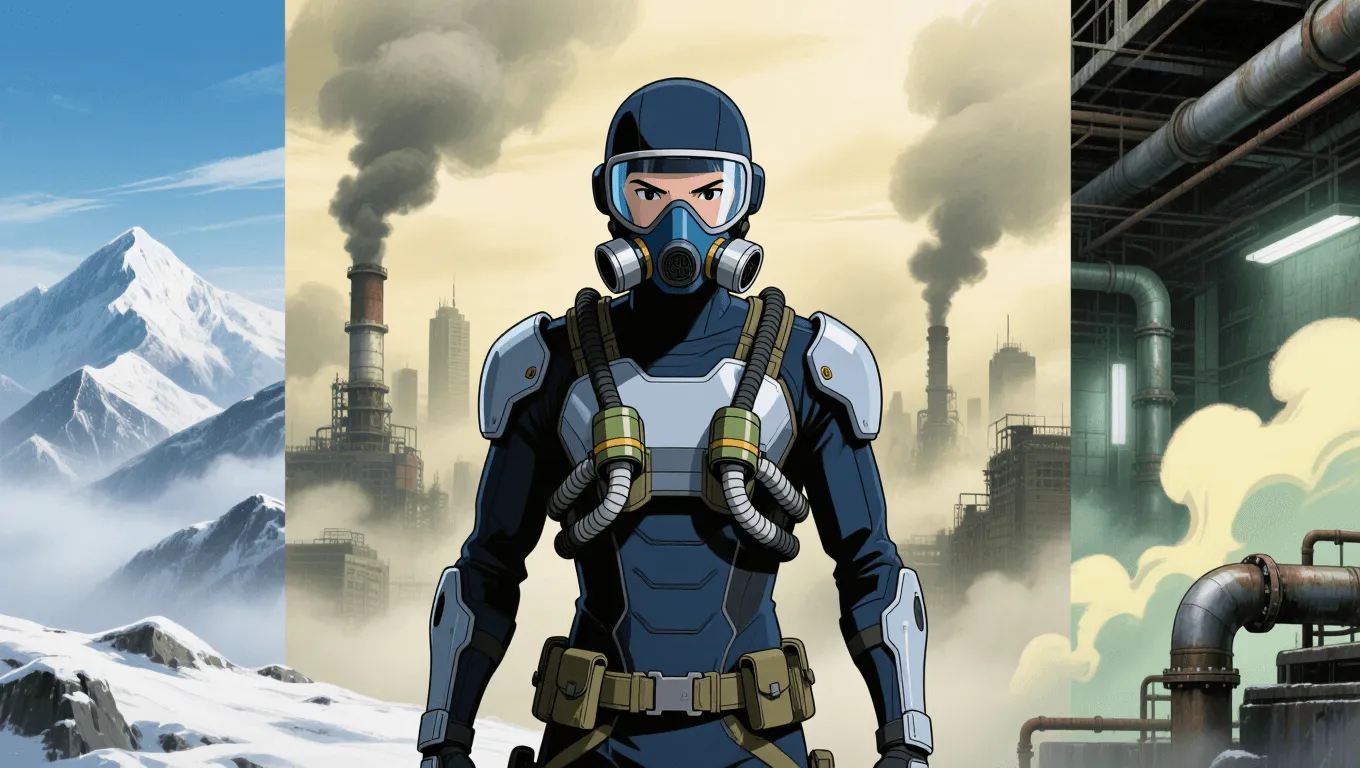Atmospheric Adaptation

Atmospheric Adaptation Video Demo 🎬
Table of Contents
- Atmospheric Adaptation Video Demo 🎬
- What Is Atmospheric Adaptation
- Core Abilities of Atmospheric Adaptation
- Application / Tactical Advantages in Combat
- Level: Level 1 🏙️, Level 2 🌇, Level 3 🌃
- Limitations of Using the Atmospheric Adaptation
- Weakness Against What Other Superpowers
- Synergistic Power Combos
- Known Users
Atmospheric Adaptation is the superpower that lets a character function optimally in any gaseous environment—from oxygen-rich skies and sulfurous alien worlds to thin high-altitude air or the vacuum of space. As a form of environmental adaptation, it blends respiratory adaptation, pressure tolerance, gas immunity, and thermoregulation to keep the user combat-ready where others would suffocate, freeze, or collapse. In stories and games, this ability unlocks high-altitude flight, orbital operations, toxic-zone infiltration, and battlefield dominance inside smoke, tear gas, or superheated ash. For readers exploring unusual powers and build ideas, see the full list in the Superpower Wiki and roll something wild with the random superpower generator.
What Is Atmospheric Adaptation
Atmospheric Adaptation is the innate capacity to breathe, move, and fight within hostile or unusual atmospheres without loss of performance or consciousness. It typically covers four pillars:
-
Universal respiration: The body extracts or synthesizes needed gases (e.g., oxygen analogs) from virtually any air mixture—or sustains activity without breathing for extended periods.
-
Pressure equalization: The user resists hypobaric (thin-air) and hyperbaric (deep-pressure) stress, preventing barotrauma, decompression sickness, and edema.
-
Thermal buffering: Efficient thermoregulation mitigates hypothermia, heatstroke, and rapid convective heat loss in high winds or thin air.
-
Contaminant defense: Built-in filtration and biochemical detoxification neutralize airborne toxins, pathogens, corrosive aerosols, and particulate hazards.
Whether framed as “vacuum survival,” “gas conversion,” or “extreme altitude adaptation,” the power’s core promise is freedom from atmospheric constraints.
Core Abilities of Atmospheric Adaptation
Universal Respiration & Gas Conversion
The user breathes safely in nitrogen, methane, ammonia-rich skies, ash storms, or smoke-filled rooms. Some versions enable anaerobic support, letting cells maintain performance with minimal oxygen, and hypercapnia tolerance, preventing CO₂ buildup from causing confusion or blackout.
Pressure Tolerance (Hypobaric & Hyperbaric)
Enhanced lung mechanics, microvascular reinforcement, and elastic tissues prevent alveolar collapse at high altitudes and barotrauma or nitrogen narcosis under deep pressure zones. Rapid transitions—e.g., explosive decompression—are buffered to avoid embolisms and the bends.
Toxin, Pathogen, and Irritant Immunity
Nanoscopic cilia, biochemical filters, or adaptive mucosa trap particulates and neutralize nerve agents, corrosive gases, allergens, and airborne pathogens. The user fights unaffected inside tear gas, chlorine clouds, volcanic sulfur dioxide, or engineered bioaerosols.
Thermal & Radiation Buffering
Thin air means volatile temperatures and more radiation. Adaptive vasoconstriction/vasodilation, micro-insulating layers, and cellular radiation hardening reduce UV and cosmic-ray damage and stabilize core temperature in jet streams or near-space edges.
Sensory Calibration in Exotic Air
Sound and smell behave differently across densities and compositions. The power auto-tunes hearing for altered acoustic propagation and adjusts olfaction to new chemical baselines, preserving situational awareness amid unfamiliar atmospheres.
Metabolic Switching & Energy Efficiency
Under extreme conditions, metabolism shifts to optimize ATP output with minimal oxygen, preventing altitude sickness and sustaining peak performance even when sprinting above 8,000 meters or maneuvering in partial vacuum.
Application / Tactical Advantages in Combat
Denied-Environment Superiority
Smoke screens, toxic gas traps, volcanic vents, or chemical weapon zones become the user’s playground. While opponents cough or retreat behind masks, the adapted fighter pushes through, flanks, and controls objectives.
High-Altitude & Near-Space Maneuvers
Stratospheric ambushes, suborbital insertions, and long-range flight at cruising altitudes are routine. Low drag and cold air no longer sap stamina or cognition, enabling surprise entries and rapid exfiltration.
Counter-CBRN and Crowd Control Immunity
Tear gas, pepper spray, neurotoxic mists, and choking smog lose potency. The user can disperse, contain, or escort civilians through contaminated sectors without protective gear.
Resilience to Decompression & Pressure Games
Vacuum exposure, explosive decompression, or pressure-crush tactics fail. The user can breach airlocks, operate on airless moons, or dive into hyperbaric industrial chambers with no time penalty for acclimatization.
Rescue, Recon, and Sustainment
Search-and-rescue through wildfires, dust storms, or chemical spills becomes feasible. Recon teams gain persistence in “no-go” skies, preserving drones and filters while the adapted scout gathers intel firsthand.
Level: Level 1 🏙️, Level 2 🌇, Level 3 🌃
Level 1 — Acclimatized Operative
-
Scope: Safe function across common terrestrial extremes—high altitude (up to Himalayan summits), polluted megacity smog, and moderate industrial toxins.
-
Feats: No altitude sickness, minimal fatigue in thin air, reliable performance inside standard riot-control agents, and resistance to choking smoke in fires.
-
Limits: Needs breathable oxygen overall; vacuum and exotic planetary atmospheres still dangerous; severe chlorine/ammonia clouds require caution.

Level 2 — Planetary Atmosphere Nomad
-
Scope: Comfortable in most gaseous mixes (methane, CO₂-dominant, sulfurous) and across wide pressure/temperature swings.
-
Feats: Operates outdoors on Mars-like worlds, inside volcanic plumes, and during explosive decompression events; shrug-offs nerve gas equivalents; robust anti-barotrauma and anti-embolism defenses.
-
Limits: Long exposures to hard radiation and extreme cryogenic or plasma-adjacent temperatures require cover; full vacuum survivability is time-limited.

Level 3 — Voidwalker
-
Scope: Sustained combat effectiveness from abyssal pressure to deep vacuum.
-
Feats: Breath-independent physiology, on-the-fly gas conversion, auto-sealing microlesions against ebullism, radiation buffering near the magnetosphere, and stable cognition without atmospheric cues.
-
Limits: Stellar-level heat, absolute-zero conditions, hard cosmic radiation bursts, or gravity extremes still demand additional defenses or synergy with other powers.

Limitations of Using the Atmospheric Adaptation
-
Adaptation latency: Some variants require moments to calibrate to a new gas mixture. Sudden shifts from oxygen to ammonia may cause brief dizziness or blurred vision as systems retune.
-
Energy & nutrient drain: Cellular filtration and thermoregulation increase caloric demand. Extended operations in vacuum or toxic clouds can deplete reserves.
-
Not a universal armor: Acidic aerosols may still burn exposed tissues; shrapnel, concussive force, and corrosive liquids remain threats.
-
Radiation ceilings: The feature mitigates UV/cosmic exposure but is not absolute; solar flares, neutron bursts, and reactor leaks can overwhelm defenses without shielding.
-
Equipment interference: Sealed suits, rebreathers, or standard masks might conflict with autonomous respiration, causing overpressure or feedback unless bypassed.
-
Psychophysiological effects: Operating without normal breathing cues can disrupt speech timing, stealth breathing rhythms, or heartbeat entrainment; the user must train for silent movement and stable cadence.
Weakness Against What Other Superpowers
-
Power Nullification / Dampening: Switches off adaptation, restoring normal human vulnerabilities to suffocation, toxins, and pressure swings.
-
Absolute Zero / Plasma Manipulation: Heat extremes outrun thermoregulation; tissues freeze or ablate faster than the buffer can respond.
-
Gravity Manipulation: Crushing g-forces or tidal stresses bypass atmospheric defenses and compromise circulation.
-
Radiation Control: Concentrated ionizing blasts can surpass radiation hardening thresholds.
-
Molecular Corrosion / Acid Generation: Direct chemical burns and dissolution ignore respiratory and pressure advantages.
-
Spatial or Telekinetic Confinement: If encased in airtight telekinetic fields that remove heat or apply shear, the threat becomes mechanical rather than atmospheric.
-
Reality Warping / Biological Rewrite: Overrides the user’s physiology, erasing adaptive traits.
Synergistic Power Combos
-
Flight or Levitation: Exploits high-altitude lanes without hypoxia or chill penalties; perfect for stratospheric patrols and suborbital hops.
-
Aerokinesis / Weather Manipulation: Control the battlefield atmosphere while remaining immune to side effects—hurricane-force winds, ashfall, or microbursts.
-
Force Fields: Add micrometeoroid and thermal shielding to make true long-duration space operations viable.
-
Pressure Control: Fine-tune local pressure for sonic booms, vacuum pockets, or shockwave mitigation while staying stable.
-
Energy Absorption / Solar Empowerment: Harvest radiation and light that would otherwise be harmful, fueling sustained action in near-space.
-
Enhanced Durability / Regeneration: Covers gaps when aerosolized acids or debris inflict damage despite respiratory immunity.
-
Terraforming / Bioengineering: Scout and seed alien worlds, with the resilience to survive proto-atmospheres and assist in planetary-scale projects.
Known Users
While few characters are explicitly labeled with this exact term, several well-known heroes and antiheroes exhibit strong variants—vacuum survival, extreme pressure tolerance, or toxin-immune respiration:
-
Silver Surfer: Cosmic energy physiology enables effortless operation in deep space without breathing.
-
Martian Manhunter: Shapeshifting alien biology provides resilience to low-oxygen environments and near-vacuum exposure in many portrayals.
-
Carol Danvers (Captain Marvel): Energy-empowered form allows spaceflight and survival in hostile atmospheres.
-
Thor Odinson: Asgardian durability lets him fight in vacuum and withstand extreme environmental stresses.
-
Namor the Sub-Mariner: Amphibious physiology demonstrates pressure tolerance and cross-medium respiration that often extends to unusual air mixes.
-
The Thing (Ben Grimm): Rocky hide and altered biology afford short-term vacuum endurance and resilience against atmospheric extremes.
For broader inspiration and crossovers, browse the rest of our superpower wiki and spark ideas with the random superpower generator to pair Atmospheric Adaptation with complementary abilities.
